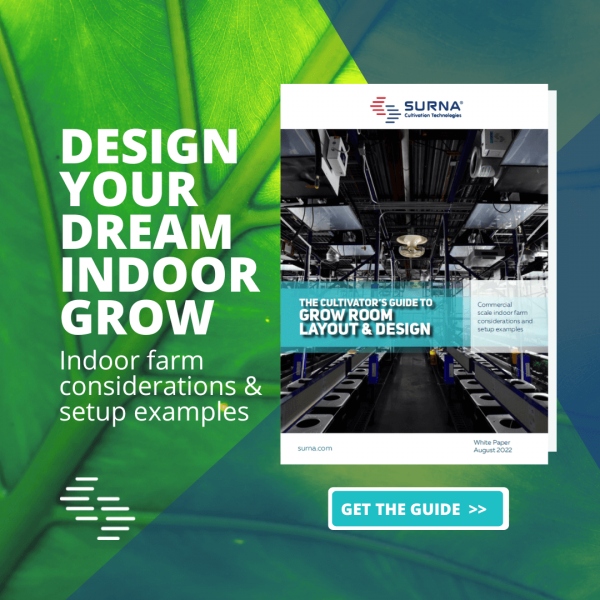Many Cannabis genetics naturally grow tall, with a similar appearance to pine trees, with one large bud on top and a smaller cola on the end of each branch. This growing method is successful outdoors because the sun moves across the sky throughout the day, allowing each branch (and bud) to receive light. However, when growing indoors, and to a lesser extent in greenhouses, this does not happen because the lights are stationary above the plants, never fully lighting the sides. Additionally, when growing indoors, it is important to keep the plant canopy as even as possible due to diminishing light intensity as the flowers get further from the light source (see: Inverse Square Law); this is not a problem with sun-grown cannabis as the sun is so far away that a few extra feet doesn’t make as much of a difference.
Check out an updated version of this blog to learn more about how to trellis cannabis.
In order to effectively provide light to all bud sites when growing indoors, trellising should be used. This creates an even plant canopy by gently bending the stalks and provides structure to grow them sideways instead of vertically. The main purpose of trellising is to mimic the even footprint of available light outdoors by bringing all of the branch’s top nodes to nearly the same distance from the light source. Doing so can increase yield by up to 30%.
Trellising happens in the Flower Room, once a plant has been trellised it will be difficult to move. Start prepping your plants for trellising in Veg by pruning them, shaping the plant so it is easy to spread out on a screen. Once the plants have been moved to Flower, follow the steps below to effectively trellis Cannabis plants.
1. When plants move into Flower, put up trellising above them. This can be extruded or molded plastic netting, nylon string, or anything similar to create a solid structure to support the plant. Avoid thin string/wiring (such as fishing line, etc…) as it may cut into the plant tissue.
The idea here is to create a grid of holes to weave branches and buds through in the next step. The ultimate goal is to have a single bud site per 6″x6″ hole in the grid. Chain link fencing is a great, reusable way to accomplish this, but can be cost prohibitive as it can cost up to 75 times a much as the plastic options.
2. Weave the branches of the plant through the trellis netting.
The branches should have been grown to be long and lanky so that they can be bent onto the trellis. The branches should bend when pinched with your fingers – the pinching won’t hurt the plant as it is capable of healing itself, but be sure not to snap the branch. Once bent, it will be possible to weave the branches as needed. As the plant continues to grow up towards the light, bend and weave it down into the trellis netting to fill any gaps.
3. Position the branches so that there is a single bud site in each hole of the trellis netting.
The trellis will create a grid with holes that are typically 6”x6”. Once the plant has been bent onto the trellis, buds will grow all over the top of the trellis (plant canopy). Keep an eye on these developing bud sites and remove any extra buds that appear – remember, the goal is a single bud per hole. Removing extra buds will help the remaining ones to grow larger.
4. If desired, create a side canopy (use vertical trellising on each side) and repeat steps 1-3 for each side.
When creating a side canopy, be sure to include vertical lighting to provide light to the bud sites on the side of the plant.
Trellising a cannabis plant can have a large impact on the final amount of product produced. By maximizing the use of available light and ensuring all buds are on an even level, the end result will be large, evenly sized buds across the entire plant canopy. Resources will be maximized, allowing the plant to produce at its maximum capacity.

